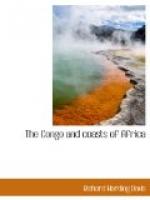How the boys who paddled the shore boats live long enough to learn how to handle them is a great puzzle. We were told that the method was to take out one green boy with a crew of eleven experts. But how did the original eleven become experts? At Accra, where the waves are very high and rough, are the best boat boys on the coast. We watched the Custom House boat fight her way across the two miles of surf to the shore. The fight lasted two hours. It was as thrilling as watching a man cross Niagara Falls on a tight-rope. The greater part of the two hours the boat stood straight in the air, as though it meant to shake the crew into the sea, and the rest of the time it ran between walls of water ten feet high and was entirely lost to sight. Two things about the paddling on the West Coast make it peculiar; the boys sit, not on the thwarts, but on the gunwales, as a woman rides a side-saddle, and in many parts of the coast the boys use paddles shaped like a fork or a trident. One asks how, sitting as they do, they are able to brace themselves, and how with their forked paddles they obtained sufficient resistance. A coaster’s explanation of the split paddle was that the boys did not want any more resistance than they could prevent.
[Illustration: The Kroo Boys Sit, Not On
the Thwarts, but On the
Gunwales, as a Woman Rides a Side Saddle.]
There is no more royal manner of progress than when one of these boats lifts you over the waves, with the boys chanting some wild chorus, with their bare bodies glistening, their teeth and eyes shining, the splendid muscles straining, and the dripping paddles flashing like twelve mirrors.
Some of the chiefs have canoes of as much as sixty men-power, and when these men sing, and their bodies and voices are in unison, a war canoe seems the only means of locomotion, and a sixty-horse-power racing car becomes a vehicle suited only to the newly rich.




